Simulation Study on the Disaster-Causing Mechanism of Geothermal Water in Deep High-Temperature Heat-Damaged Mines
Abstract
1. Introduction
2. Overview of the Mine
3. Determination of Thermal Environment Parameters in the Mine
3.1. Determination of the Thermal Parameters of the Roadway Airflow
3.2. Determination of the Original Rock Temperature of the Roadway
3.3. Test of the Thermal Physics Parameters of the Surrounding Rock
4. Numerical Model for Seepage-Heat Transfer of Pressurized Geothermal Water Upwelling
4.1. Model Assumptions
- Free flow of airflow from the mouth of the roadway with no return flow.
- Disregard the effect of roadway excavation on the extension of fractures, which are much longer than their width.
- Ignore the effect of fractures in the overburden of the roadway, and ignore smaller fractures.
- The fractured rock is isotropic and thermal physics parameters stable.
- The fracture flow is a steady laminar flow of incompressible fluid with no phase change during flow.
4.2. Model Building
4.3. Model Mesh-Independence Verification
4.4. Model Parameters and Boundary Condition Settings
4.5. Model Characteristics
- A geothermal gradient was set for the model as a whole, and the sandy mudstone and limestone rock layers were assigned values between them by a segmentation function, consistent with field measurements.
- Generation of random fractures in tuffs by the Monte Carlo method.
- Groundwater upwelling process is local rapid upwelling along the fracture, the fracture set as a heat source, and the rock around the fracture for heat exchange causes perturbation to the surrounding rock temperature field.
- The rock stratum is a porous medium; the solid medium is the lower surrounding rock; and the fluid medium is groundwater, containing heat conduction and heat convection, setting up its internal fluid flow to satisfy Darcy’s law, so that the overall flow of geothermal water within it is a seepage upwelling process.
- Coupling of fracture flow and Darcy flow fields, coupling of fracture heat transfer and porous media heat transfer, setting heat fluxes and boundary heat sources to fractures.
- Coupling of airflow laminar flow field and Darcy flow field, coupling of fluid heat transfer and porous media heat transfer, and setting up convective heat transfer and heat conduction on both sides of the rock wall.
5. Simulation Results and Analyses
5.1. Model Validation and Error Analysis
5.2. Distribution of Airflow Temperature Field in Roadway
- In the 0~50 m stage, the airflow temperature is basically unchanged and the same as the airflow temperature at the entrance of the roadway, and the warming rate is basically 0. Because the temperature of the airflow into the roadway is 20 °C, before the thermal equilibrium, the difference between the airflow temperature and the roadway surrounding rock temperature is very big. There will therefore be energy continuously flowing from the high temperature surrounding rock into the low temperature airflow, and the heat exchange efficiency of the two becomes larger. The temperature of the surrounding rock decreases at it loses energy, and the temperature of the airflow gaining energy increases; the temperature difference between the two gradually decreases, but the outside world will also continuously reduce the temperature of the airflow, so that the temperature of the airflow will always stay the same. The energy gained by the surrounding rock from the geothermal water is much smaller than the energy lost, so the temperature of the surrounding rock will keep decreasing until it is the same as that of the wind flow, and fanally reaches thermal equilibrium. After that, the temperature of the surrounding rock has basically been reduced to 20 °C, at which time the heat exchange efficiency is almost 0, and the airflow temperature will not be warmed up.
- In the 50~130 m stage, the airflow temperature begins to change, and the slope of the curve represents the airflow heat rate beginning to increase. The reason for this is that with the continuous extension of the roadway, the heat contributed by the geothermal water to the surrounding rock at each stage will also accumulate. Thus, the temperature of the surrounding rock will gradually increase, and the energy absorbed by the airflow to the surrounding rock will gradually be smaller than the energy contributed by the geothermal water to the surrounding rock, at which time the temperature difference between the two will continuously increase, and the heat exchange efficiency will increase. The cooling efficiency of airflow will gradually slow down, but it will still absorb heat from the surrounding rock to raise its own temperature and reduce the heating rate of the surrounding rock.
- In the final stage of over 130 m, the warming rate of the airflow remains basically the same, and the temperature of the airflow increases linearly along the course until it exits the roadway as this goes ever deeper. This is because after 130 m, the heat contributed by the geothermal water to the surrounding rock and the heat absorbed by the airflow is already in equilibrium, and the heat exchange between the airflow and the surrounding rock is already saturated and unchanged, so the heating rate will remains basically unchanged until the exit of the roadway.
5.3. Effect of Hot Storage Geothermal Water Pressure on Airflow Temperature in the Roadway
5.4. Effect of Hot Storage Geothermal Water Temperature on Airflow Temperature in the Roadway
6. Conclusions
- Analysis has been carried out of the influence of geothermal water upwelling on the distribution law of airflow temperature field inside the roadway and the change law of air temperature at the exit of the roadway by establishing the model and controlling the variables of upwelling water temperature and upwelling water pressure.
- A roadway seepage-heat transfer model has been established with actual data as the standard, and the error of the model verified, generating random fissures by the Monte Carlo method, and studying the influence of temperature and pressure of geothermal water upwelling through fissures on the temperature field of roadway airflow.
- At steady state, the temperature of airflow in the roadway rises at a slow rate 50 m from the roadway entrance. With increasing depth of the roadway, the warming effect of the surrounding rock temperature on the airflow becomes gradually more obvious, the heat exchange efficiency between the two increases, and the airflow temperature starts to rise steadily in a linear relationship after thermal equilibrium.
- With different upwelling water temperature and upwelling water pressure, the law of change in airflow temperature with time remains basically the same. At the beginning, after 1500 m of the roadway, the airflow is heated to its highest temperature; with the continuous injection of fresh cold airflow, cooling rate and efficiency take 0–25 days to reach their maximum. With increasing time, the surrounding rock heat is absorbed by the airflow thus reducing the temperature, and the cooling effect gradually slows down. When the roadway upwelling water temperature is 50 °C, after 300 days, the temperature will be reduced by 18 °C.
- The temperature of upwelling geothermal water has a huge impact on the heat exchange efficiency and temperature field of the surrounding rock, and the highest difference of 4.3 °C in the temperature of the roadway when the temperature of the upwelling water differs by 20 °C. The temperature in the roadway is basically the same when the difference in upwelling water pressure is 4 MPa, with the highest difference of 0.3 °C.
- Research shows that the main factor affecting the airflow in the roadway is the temperature of the upwelling geothermal water. Therefore, measures such as laying heat insulation materials at the bottom of the roadway, evacuating and releasing geothermal water, and circulating and injecting cold water could be applied to effectively reduce the influence of geothermal water temperature on the temperature field of roadway airflow and improve the mine thermal environment.
Author Contributions
Funding
Data Availability Statement
Acknowledgments
Conflicts of Interest
References
- Wan, Z.; Zhang, Y.; Cheng, J.; Zhou, C.; Gu, B.; Zhou, P. Mine geothermal and heat hazard prevention and control in China. Disaster Adv. 2013, 6, 85–93. [Google Scholar]
- Zhang, Y. Research on Unsteady Temperature Field and Thermal Insulation and Cooling Mechanism of High Ground Temperature Roadway Surrounding Rock. Ph.D. Thesis, China University of Mining and Technology, Xuzhou, China, 2013. [Google Scholar]
- Xu, G.; Wang, W.; Zhang, H. Analysis of deep heat damage in Huainan mine area and study of hot water resource utilization. China Coal 2009, 10, 4. [Google Scholar]
- Wan, Z.J.; Bi, S.; Zhang, Y. Theoretical and technological framework for coal-thermal co-mining. J. Coal 2018, 43, 8. [Google Scholar]
- Sheying, J.; Yubin, Y.; Baoqiang, C. Formation factors of high temperature heat damage in Pingdingshan coal mine and prevention and control measures. Mod. Agric. Sci. Technol. 2009, 11, 2. [Google Scholar]
- Zhang, Y.C. Research on heat damage management technology and cooling effect of Zhuji mine. Coal Mine Saf. 2015, 46, 3. [Google Scholar]
- Pei, F.; Ba, Y.; Wang, Z. Geotectonic features and evolution of the Pingdingshan area. Proc. Henan Prov. Geol. Surv. Res. Bull. 2007, 26–33. [Google Scholar]
- Dong, X.; Zhang, J.; Hou, X. Deep geothermal resources in the Pingdingshan mining area. J. Hebei Union Univ. Nat. Sci. Ed. 2014, 36, 4. [Google Scholar]
- Wang, Y.; Wang, L.; Hu, D.; Guan, J.; Bai, Y.; Wang, Z.; Jiang, G.; Hu, J.; Tang, B.; Zhu, C. The present-day geothermal regime of the North Jiangsu Basin, East China. Geothermics 2020, 88, 101829. [Google Scholar] [CrossRef]
- Wen, G.; Zhang, H.; Deng, Y. Classification of hydrogeological units in the Pingdingshan coalfield. Coal Mine Saf. 2013, 4, 5. [Google Scholar]
- Zhang, Y.; Yuan, X.; Ma, Y. Parameter sensitivity of heat-flow coupling in granite double fractures. J. Jilin Univ. 2022, 52, 1–11. [Google Scholar]
- Chen, L.; LI, J.; Zhang, Y.; Han, F.; Ji, C.; Zhang, J. Study on coupled heat transfer and seepage in large sparsely fractured surrounding rocks in deep underground spaces. Appl. Therm. Eng. 2019, 162, 114277. [Google Scholar] [CrossRef]
- Huang, Y.; Zhang, Y.; Yu, Z.; Ma, Y.; Zhang, C. Experimental investigation of seepage and heat transfer in rough fractures for enhanced geothermal systems. Renew. Energy 2019, 135, 846–855. [Google Scholar] [CrossRef]
- Stepanov, S.; Nikiforov, D.; Grigorev, A. Multiscale Multiphysics Modeling of the Infiltration Process in the Permafrost. Mathematics 2021, 9, 2545. [Google Scholar] [CrossRef]
- Taye, J.; Kumar, B. Experimental Study on Near-bed Flow Turbulence of Sinuous Channel with Downward Seepage. Water Manag. 2020, 174, 173–186. [Google Scholar] [CrossRef]
- Shao, Y.; Yao, C.; Chibin, B. Numerical study on the coupling of seepage and heat transfer in three-dimensional complex fractured rock masses. J. Undergr. Space Eng. 2021, 4, 1063–1069. [Google Scholar]
- Ghafoori, Y.; Maek, M.; Vidmar, A.; Říha, J.; Kryžanowski, A. Analysis of Seepage in a Laboratory Scaled Model Using Passive Optical Fiber Distributed Temperature Sensor. Water 2020, 12, 367. [Google Scholar] [CrossRef]
- Chen, L.; Zhang, Y. Numerical simulation study of coupled seepage and heat transfer in the roadway envelope. Min. Res. Dev. 2017, 37, 6. [Google Scholar]
- Chen, L.; Chu, Y.; Zhang, Y.; Han, F.; Zhang, J. Analysis of Heat Transfer Characteristics of Fractured Surrounding Rock in Deep Underground Spaces. Math. Probl. Eng. 2019, 2019, 1926728. [Google Scholar] [CrossRef]
- Ma, Y.; Gan, Q.; Zhang, Y.; Yuan, X. Experimental study of heat transfer between fluid flowing through fracture surface with tortuous seepage path. Renew. Energy 2022, 188, 81–95. [Google Scholar] [CrossRef]
- Xin-Xin, L.I.; Dian-Qing, L.I.; Yi, X.U. Equivalent simulation method of three-dimensional seepage and heat transfer coupling in fractured rock mass of geothermal-borehole system. Eng. Mech. 2019, 36, 238–247. [Google Scholar]
- Yang, Z.; Wang, J.; Long, X.; Wang, X. Numerical Investigation of Seepage and Heat Transfer in Rocks with Various Fracture Patterns for Geothermal Energy Extraction. Geofluids 2022, 2022, 3918840. [Google Scholar] [CrossRef]
- Luo, J.; Zhu, Y.; Guo, Q.; Tan, L.; Zhuang, Y.; Liu, M.; Zhang, C.; Xiang, W.; Rohn, J. Experimental investigation of the hydraulic and heat-transfer properties of artificially fractured granite. Sci. Rep. 2017, 7, 39882. [Google Scholar] [CrossRef] [PubMed]
- Maghoul, P. Numerical Simulation for Foundations Energy Efficiency in Cold Region. In Proceedings of the 6th Biot Conference on Poromechanics, Paris, France, 9–13 July 2017. [Google Scholar]
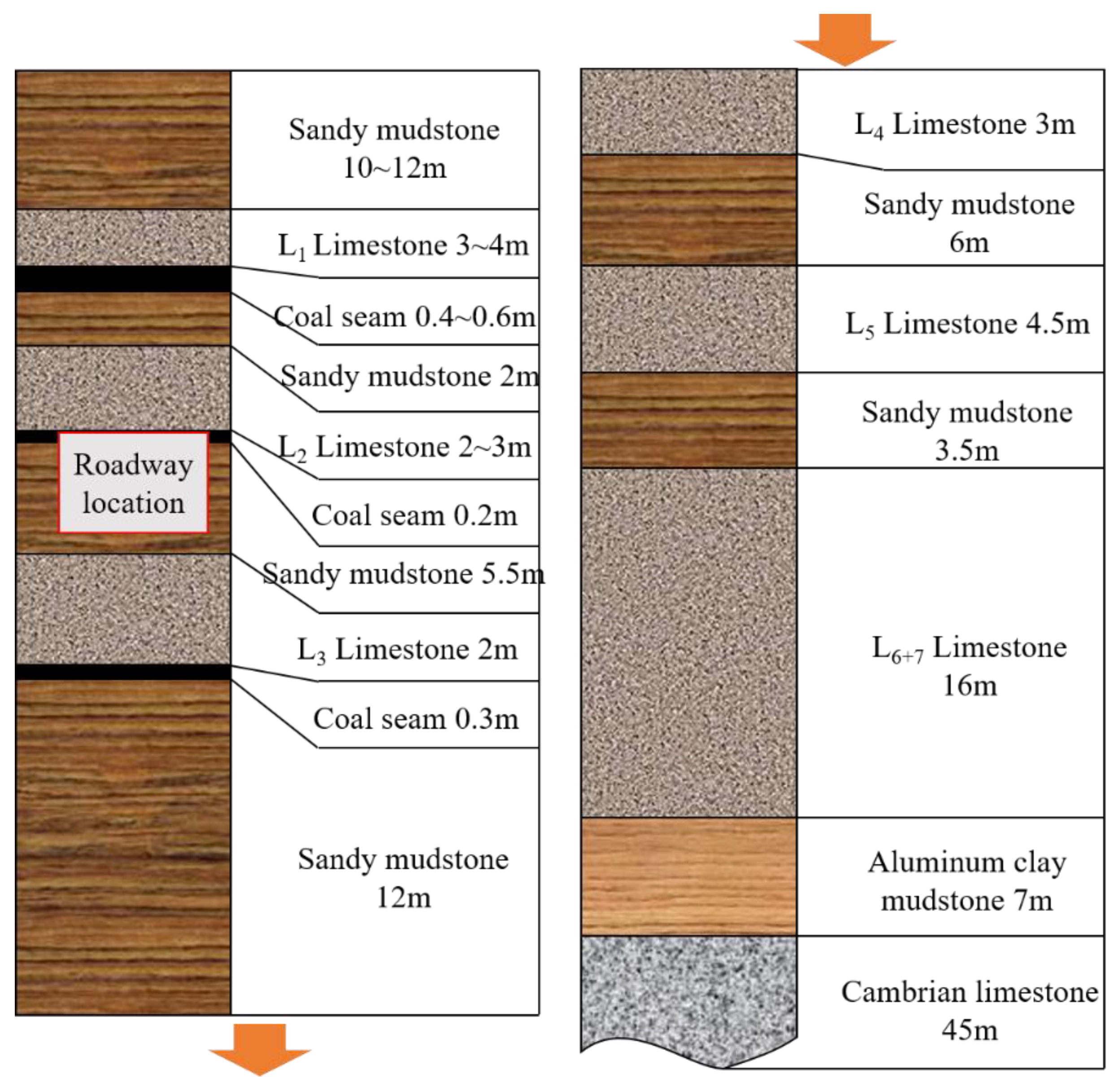
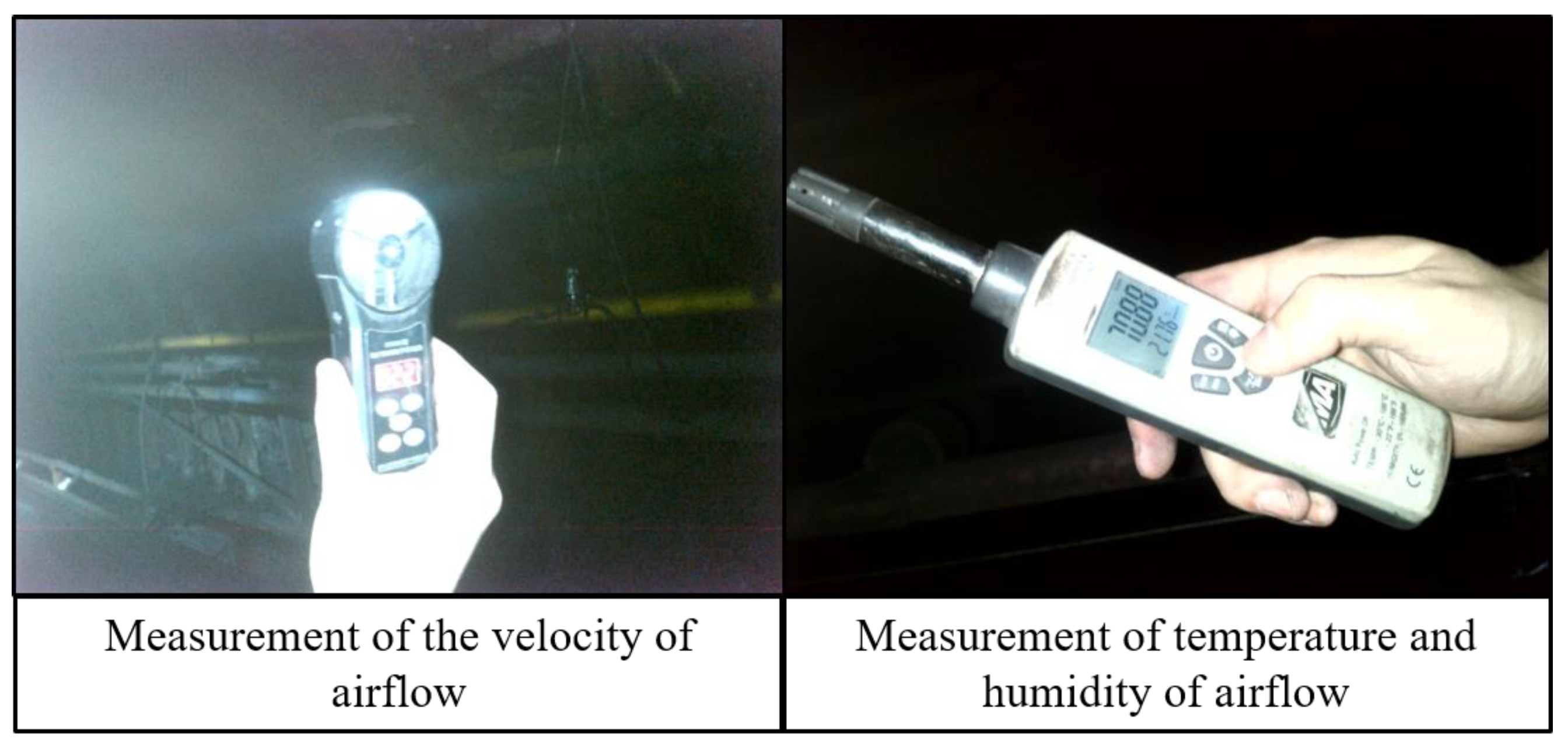
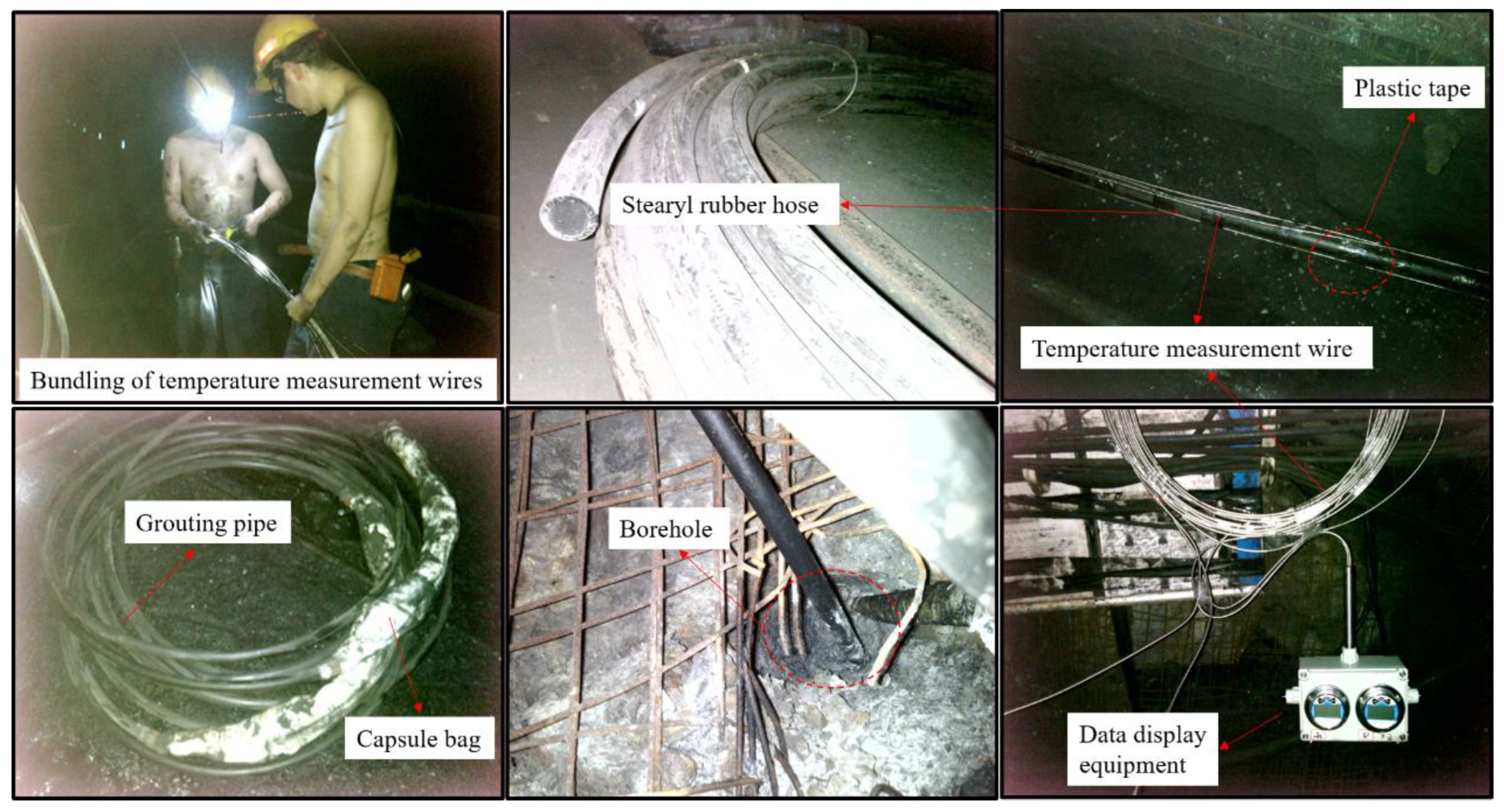
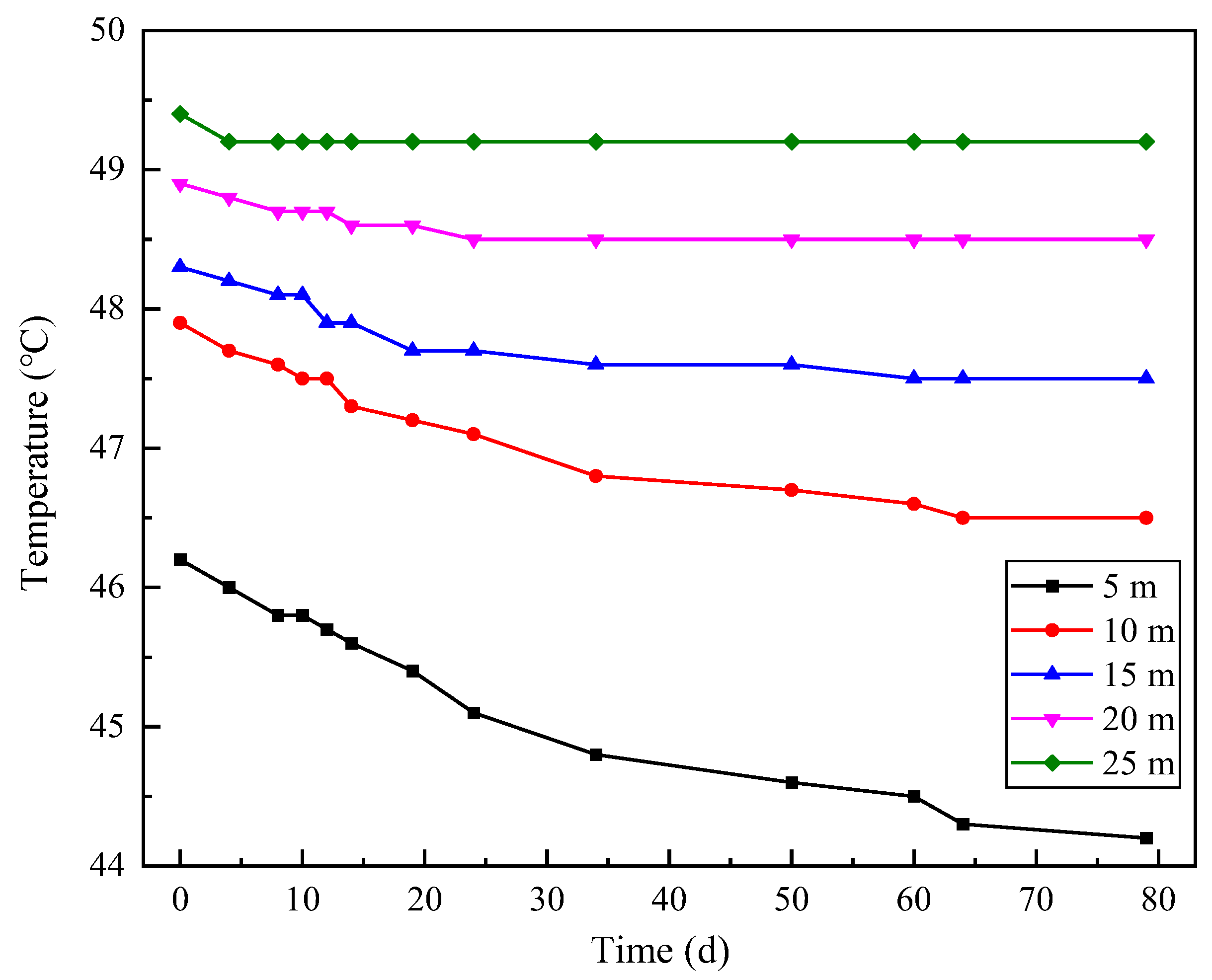
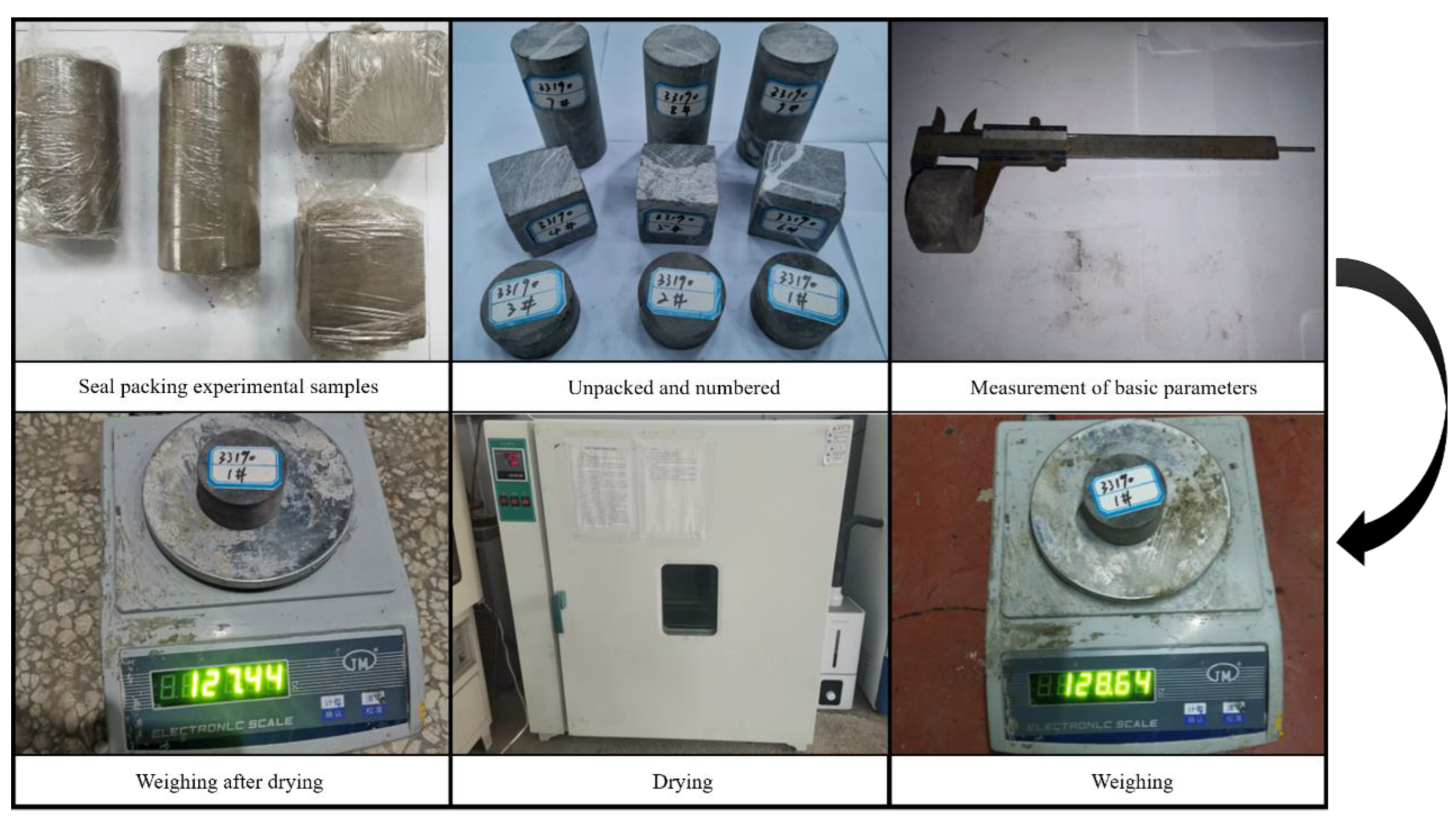

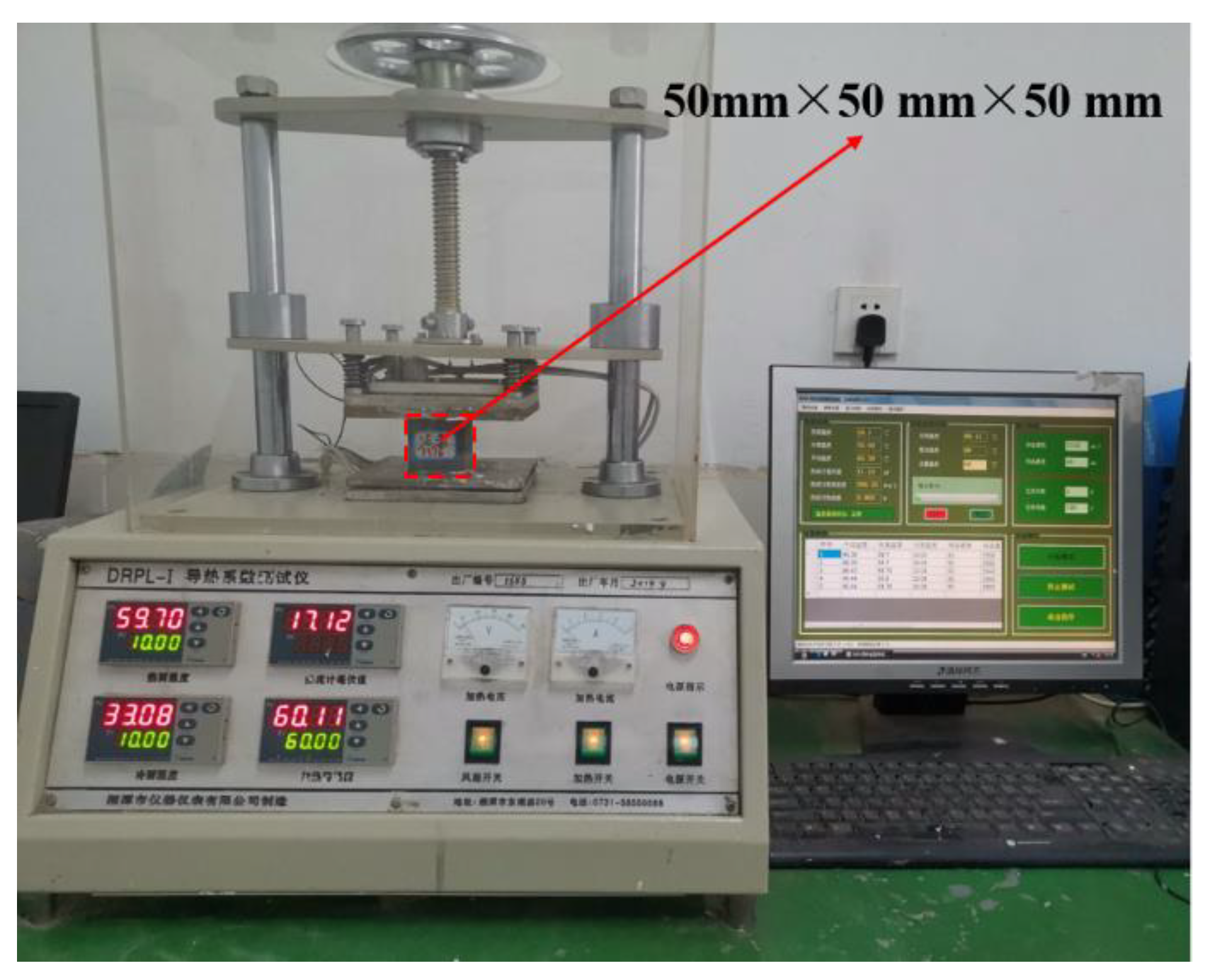




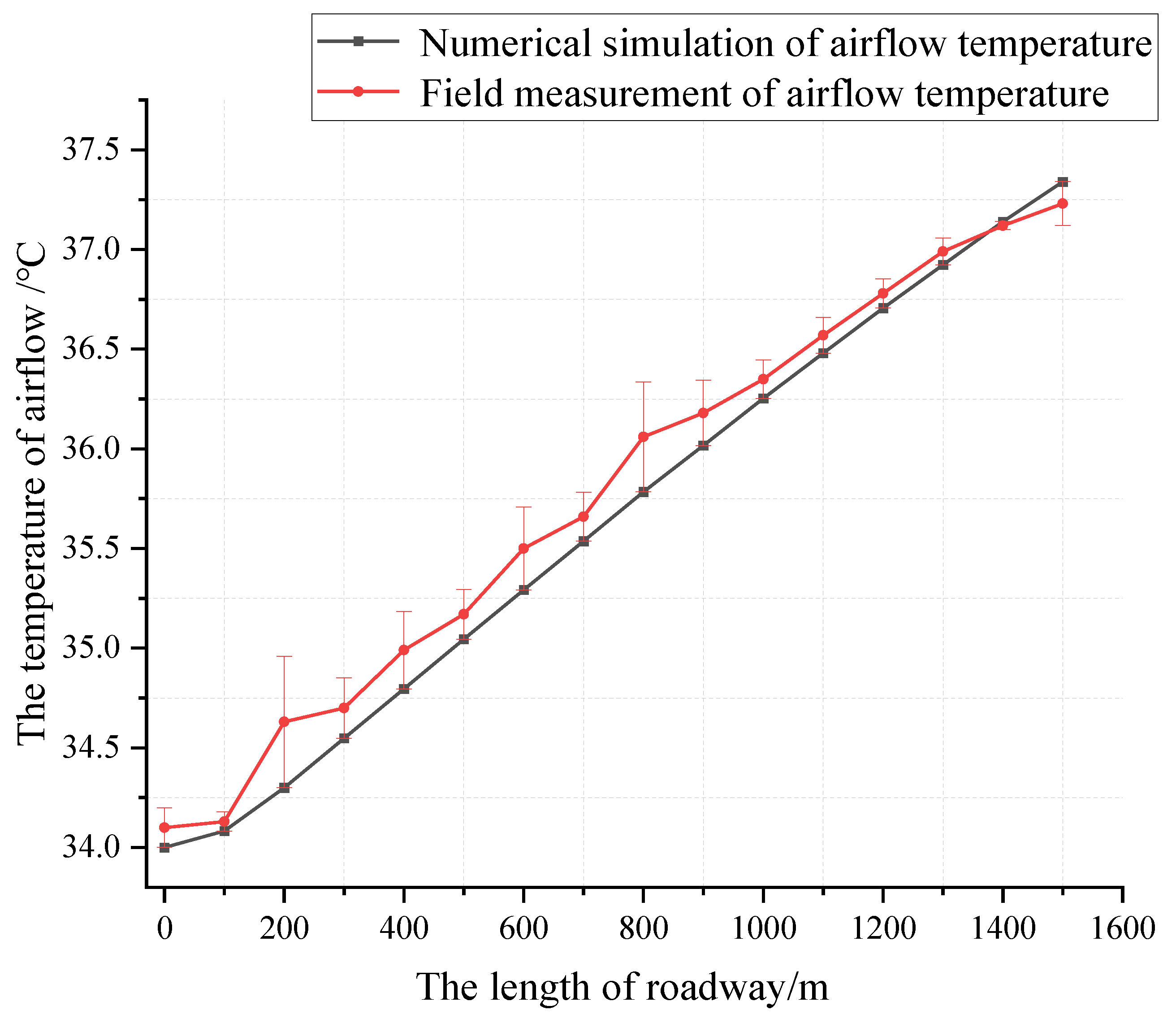
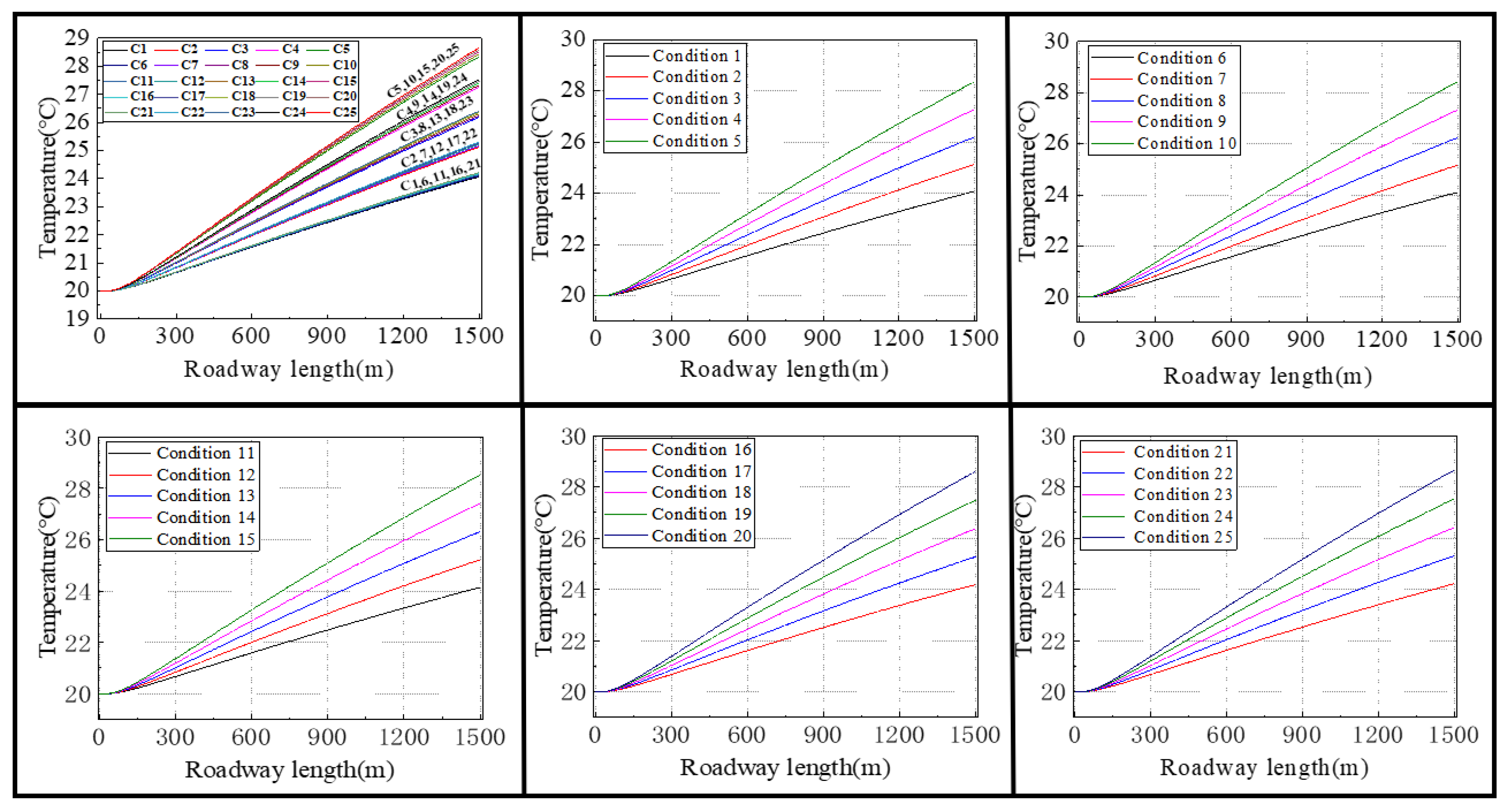
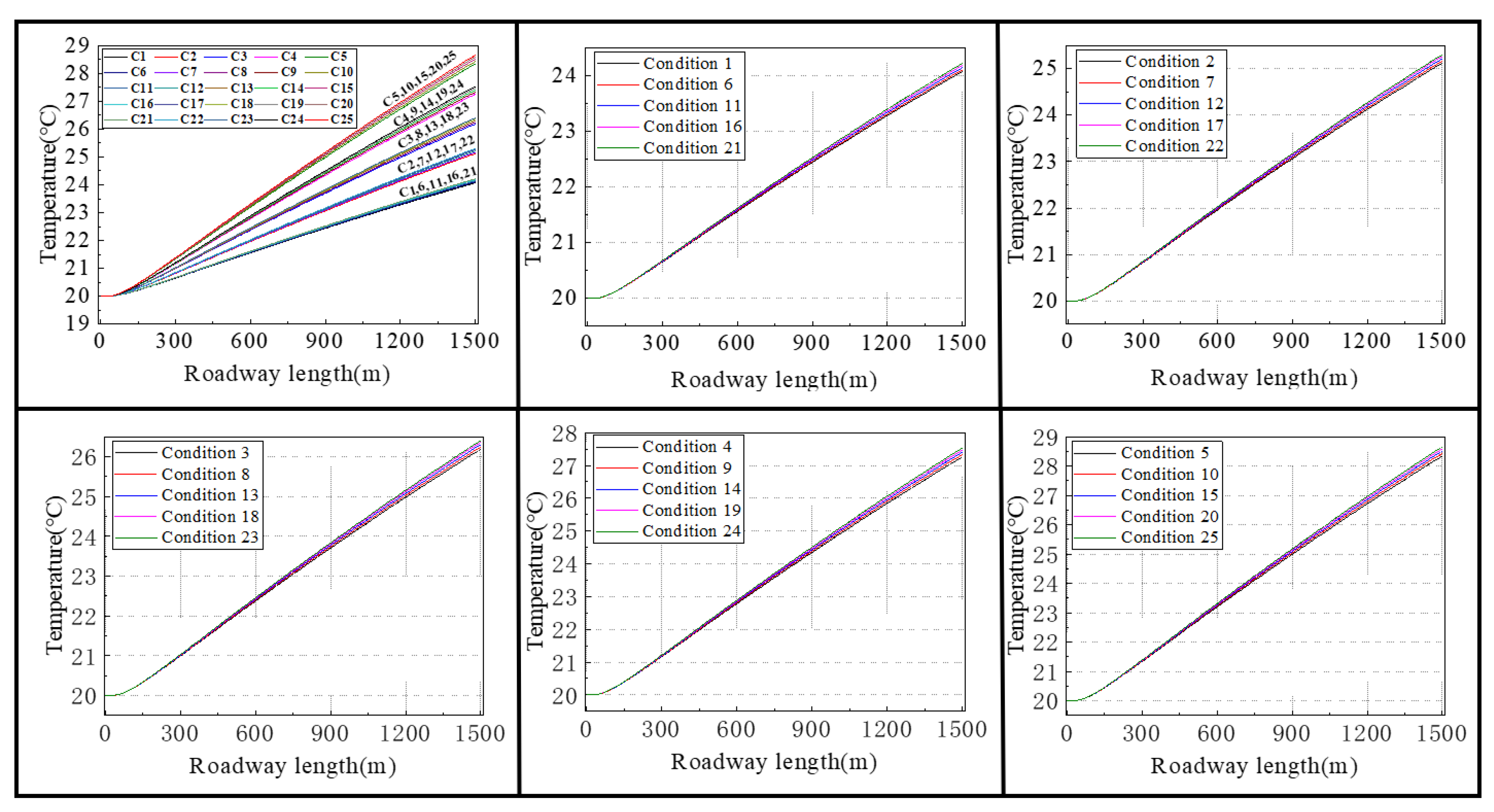
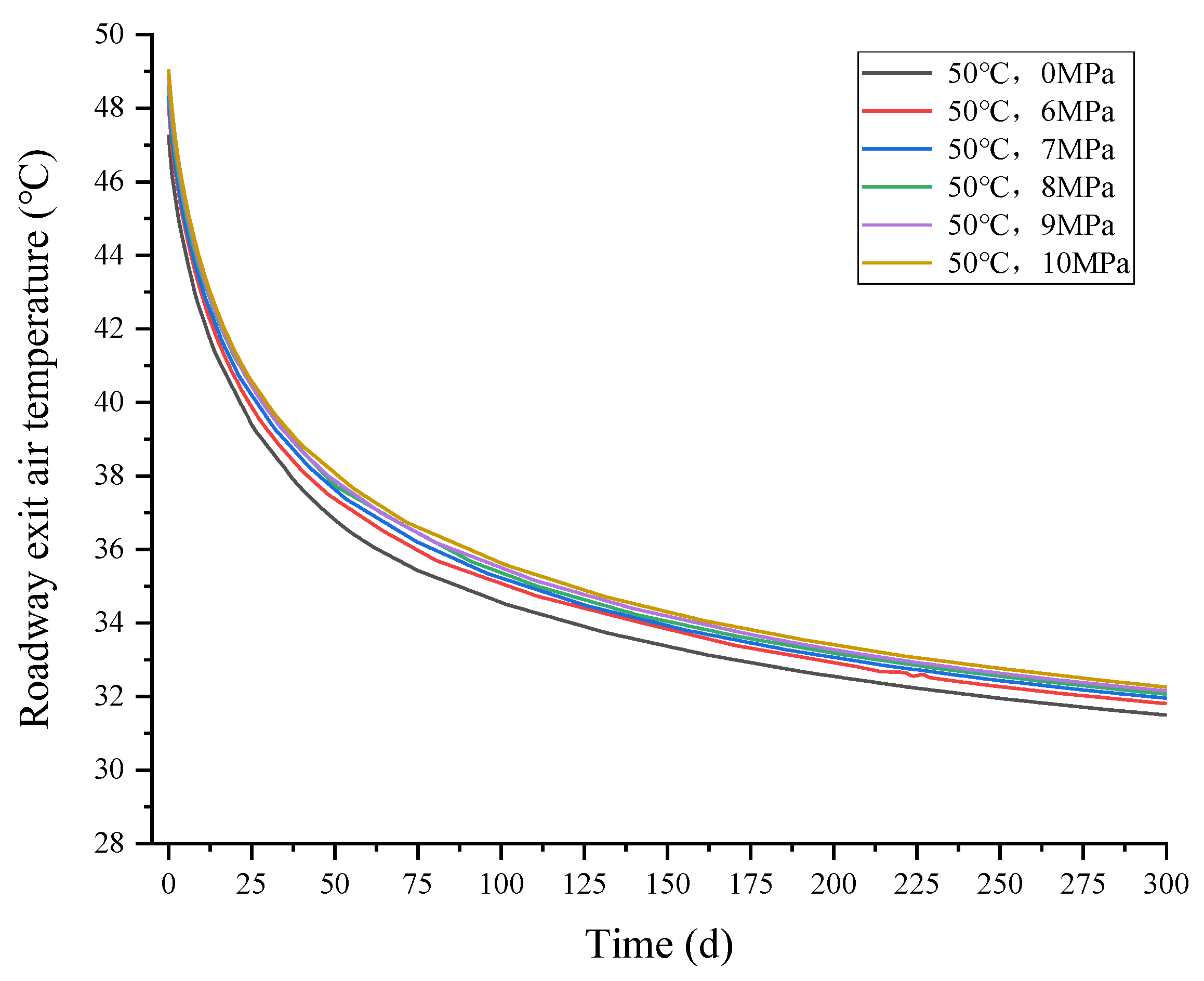
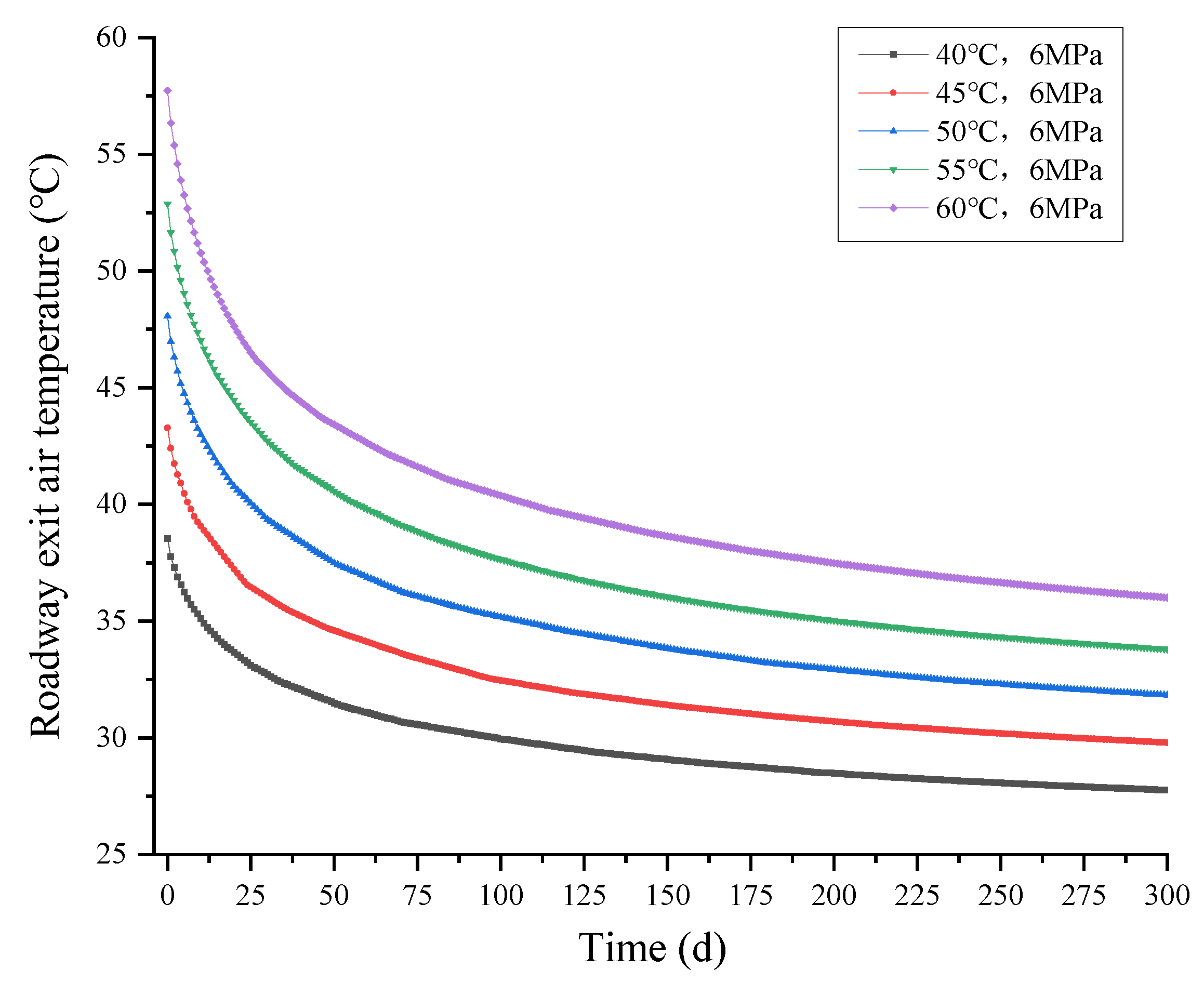
| Specimen Number | Rock Characteristics | Natural Density (g/cm3) | Dry Density (g/cm3) | Water Content (%) | Porosity | Thermal Conductivity W/(m·K) |
|---|---|---|---|---|---|---|
| 1 | sandy mudstone | 2.59 | 2.56 | 1.14% | 12.26% | 2.13 |
| 2 | sandy mudstone | 2.57 | 2.54 | 1.13% | 11.53% | 2.11 |
| 3 | sandy mudstone | 2.58 | 2.55 | 1.13% | 11.86% | 2.19 |
| average value | 2.58 | 2.55 | 1.13% | 11.88% | 2.15 | |
| 4 | limestone | 2.71 | 2.71 | 0.09% | 8.97% | 2.72 |
| 5 | limestone | 2.71 | 2.71 | 0.09% | 9.16% | 2.68 |
| 6 | limestone | 2.70 | 2.69 | 0.11% | 9.07% | 2.67 |
| average value | 2.71 | 2.70 | 0.096% | 9.07% | 2.69 |
| Grid Division | Location of Measurement Points/m | |||||
|---|---|---|---|---|---|---|
| 0 | 300 | 600 | 900 | 1200 | 1500 | |
| Extremely Coarsening | 20 | 20.48 | 21.61 | 22.91 | 24.18 | 25.37 |
| Super Coarsening | 20 | 20.48 | 21.60 | 22.88 | 24.14 | 25.33 |
| More Coarsening | 20 | 20.63 | 21.82 | 23.12 | 24.79 | 25.67 |
| Coarsening | 20 | 20.96 | 22.37 | 23.67 | 25.01 | 26.14 |
| General | 20 | 21.01 | 22.41 | 23.75 | 25.04 | 26.23 |
| Refining | 20 | 21.10 | 22.56 | 23.89 | 25.15 | 26.38 |
| More Refining | 20 | 21.02 | 22.41 | 23.78 | 25.08 | 26.29 |
| Super Refining | 20 | 20.76 | 22.07 | 23.36 | 24.65 | 25.94 |
| Extremely Refining | 20 | 20.82 | 22.17 | 23.51 | 24.82 | 26.02 |
| Average Temperature | 20 | 20.81 | 22.11 | 23.43 | 24.76 | 25.93 |
| Maximum Error | 0 | 1.43% | 2.02% | 1.95% | 1.57% | 1.73% |
| Average Error | 1.74% | |||||
| Thermal Conductivity | Convection Heat Transfer Coefficient | Density | Constant Pressure Specific Heat Capacity | Porosity | Permeability |
|---|---|---|---|---|---|
| 2.1~2.7 W/(m·K) | 25 W/(m2·K) | 2600~2700 kg/m3 | 680~870 J/(kg·K) | 0.06~0.09 | 1 × 10−16 to 1 × 10−14 m2 |
| Location of Measurement Points/m | Roadway Airflow Temperature from Numerical Simulation/°C | On-Site Measurement of Roadway Airflow Temperature/°C | Error(%) |
|---|---|---|---|
| 0 | 34 | 34.1 | 0.29% |
| 100 | 34.08 | 34.13 | 0.14% |
| 200 | 34.3 | 34.63 | 0.96% |
| 300 | 34.55 | 34.7 | 0.44% |
| 400 | 34.8 | 34.99 | 0.56% |
| 500 | 35.05 | 35.17 | 0.36% |
| 600 | 35.29 | 35.5 | 0.59% |
| 700 | 35.54 | 35.66 | 0.35% |
| 800 | 35.78 | 36.06 | 0.77% |
| 900 | 36.02 | 36.18 | 0.45% |
| 1000 | 36.25 | 36.35 | 0.27% |
| 1100 | 36.48 | 36.57 | 0.24% |
| 1200 | 36.71 | 36.78 | 0.20% |
| 1300 | 36.92 | 36.99 | 0.18% |
| 1400 | 37.14 | 37.12 | 0.05% |
| 1500 | 37.34 | 37.23 | 0.29% |
| Average error | 0.38% | ||
| Water Upwelling Temperature/°C | Water Upwelling Pressure/MPa | ||||
|---|---|---|---|---|---|
| 6 | 7 | 8 | 9 | 10 | |
| 40 | C 1 | C 2 | C 3 | C 4 | C 5 |
| 45 | C 6 | C 7 | C 8 | C 9 | C 10 |
| 50 | C 11 | C 12 | C 13 | C 14 | C 15 |
| 55 | C 16 | C 17 | C 18 | C 19 | C 20 |
| 60 | C 21 | C 22 | C 23 | C 24 | C 25 |
| Upwelling Water Temperature/°C | Airflow Temperature in the Outlet after 300 days/°C | Temperature Difference/°C |
|---|---|---|
| 40 | 27.7 | 12.3 |
| 45 | 29.8 | 15.2 |
| 50 | 31.8 | 18.2 |
| 55 | 33.8 | 21.2 |
| 60 | 36 | 24 |
Publisher’s Note: MDPI stays neutral with regard to jurisdictional claims in published maps and institutional affiliations. |
© 2022 by the authors. Licensee MDPI, Basel, Switzerland. This article is an open access article distributed under the terms and conditions of the Creative Commons Attribution (CC BY) license (https://creativecommons.org/licenses/by/4.0/).
Share and Cite
Fan, B.; Shi, P.; Wan, Z.; Zhang, Y.; Xiong, L.; Hu, S.; Gou, H. Simulation Study on the Disaster-Causing Mechanism of Geothermal Water in Deep High-Temperature Heat-Damaged Mines. Minerals 2022, 12, 1355. https://doi.org/10.3390/min12111355
Fan B, Shi P, Wan Z, Zhang Y, Xiong L, Hu S, Gou H. Simulation Study on the Disaster-Causing Mechanism of Geothermal Water in Deep High-Temperature Heat-Damaged Mines. Minerals. 2022; 12(11):1355. https://doi.org/10.3390/min12111355
Chicago/Turabian StyleFan, Bowen, Peng Shi, Zhijun Wan, Yuan Zhang, Luchang Xiong, Songbo Hu, and Hong Gou. 2022. "Simulation Study on the Disaster-Causing Mechanism of Geothermal Water in Deep High-Temperature Heat-Damaged Mines" Minerals 12, no. 11: 1355. https://doi.org/10.3390/min12111355
APA StyleFan, B., Shi, P., Wan, Z., Zhang, Y., Xiong, L., Hu, S., & Gou, H. (2022). Simulation Study on the Disaster-Causing Mechanism of Geothermal Water in Deep High-Temperature Heat-Damaged Mines. Minerals, 12(11), 1355. https://doi.org/10.3390/min12111355







